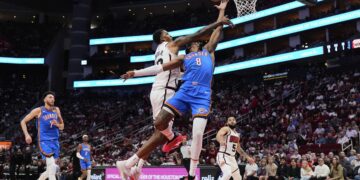Although it may not seem it, winter is the perfect time to get out and be a wildlife watcher! Reduced vegetation and migrations of northern birds, especially hawks, make these majestic birds easy to see this time of year — if you have not been out, or not noticed — they are everywhere!
Posts on the Oklahoma Ornithological Society and Oklahoma Bird Watchers Facebook pages have been very active with great pictures of owls, hawks and eagles from all across the Sooner State!
Raptors, or birds of prey, can be found hunting all across the state and are a great group of birds to test your bird-watching skills. They are large, colorful, and perch in the open on fences, treetops and high line poles. The only challenge may be determining what species you are witnessing.
The term “raptor” can include hawks, eagles, owls, falcons, and sometimes even vultures. They typically have hooked beaks and sharp talons and hunt for meat. Bird watchers may find as many as 20 different species if they look long and hard enough. From the large red-tailed hawk to the minuscule kestrel, there are plenty of different species to see.
Bald eagles flock to the state each winter to fish in open waters and can be seen along many rivers and lakes. Hawks and falcons can often be spotted perched along tree lines, power poles, or fencerows. And owls can be heard and seen across the state. Though rural areas tend to offer more raptor-watching locations, urban parks and established neighborhoods can also be great raptor-watching locations.
Here are some tips to for watching these majestic birds from Hawkwatch International:
· Get some good binoculars — The most helpful tool for birders (and hawk watchers in particular) is a pair of binoculars. For new hawk watchers, it is best to arm yourself with a quality pair of binoculars that offer a clear, sharp image compared to a lower grade model that may be lacking in quality, or tire your eyes quickly.
· Do some research — Before delving deep into the identification aspect of watching hawks, it is helpful to understand how to approach identification. It is not as easy as memorizing your field guide; there is much more to identifying birds in flight. Learn the basics — the basic shape, flight mannerisms, and plumage to be adept at identifying flying raptors.
· Get a good field guide – There are several good and bad field guides out there. The best are the ones that you can reference quickly with good descriptions and photos or drawings. I really like the National Geographic Field Guide to the birds of North America. It is simple enough for beginners and has enough information for more experience birders.
· Learn from others – There is no better way to learn than to have a mentor. Find someone that doesn’t mind you tagging along on an outing or two and just absorb their knowledge. To find other birders, follow Oklahoma Bird Watchers on Facebook. There are also lots of good photos, tips and information posted on their page.
· Practice makes perfect — Learning how to spot birds is a skill in itself. When visiting a hawk migration site, sometimes it is noticeable that one or two people are spotting the majority of the birds. Everybody has their own way of doing things, but spotting birds takes practice, just as identifying them does. It is natural to scan with your binoculars across the horizon since it is easy on the eyes and there is always some background or point of reference in your field that helps keep your eyes focused.
· Safety first — Birding by car is a convenient way to watch raptors, especially on cold winter days. But don’t watch birds more than you watch the road! Stay alert, ask your birding partner to watch for hazards, and find a safe pull off before you focus on the sky and take your eyes off the road.
· Don’t forget about urban areas – Too many times we think that wildlife has to be in the wilderness – that’s just not so. Many hawks will frequent back yards, parks and other urban settings looking for food. Bird feeders concentrate prey for raptors like coopers and sharp-shinned hawks, and it seems like we always have owls visiting our neighborhood.
Regardless of the time or season you watch birds, you can always share photos and sighting details with the Wildlife Department, or on free platforms like eBird or iNaturalist, added Donnell.
Want to reach a local audience and grow your business?
Our website is the perfect platform to connect with engaged readers in your local area.
Whether you're looking for banner ads, sponsored content, or custom promotions, we can tailor a package to meet your needs.
Contact us today to learn more about advertising opportunities!
CONTACT US NOW





